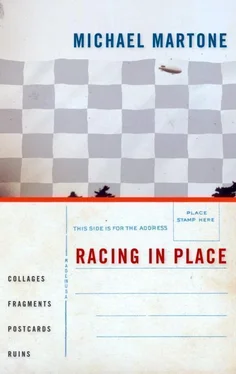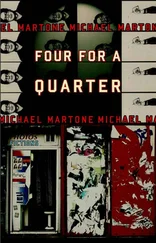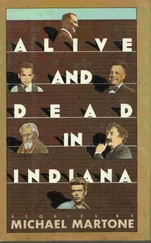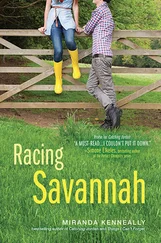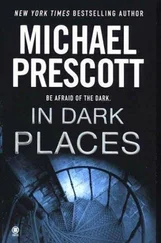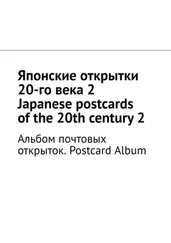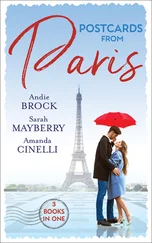I discovered that Ames was an outlet for Collegiate Pacific, a company that manufactures licensed trademark apparel. I discovered this when I was taken to one of the factory's open houses where we locals were invited semiannually to come in and take the mistakes and misprinted items off their hands for a significantly reduced price. And that had been another thing I noticed about my new town. While the official cardinal had been the predominant mascot fauna, I couldn't help but notice the eclec tic nature exhibited by the populace on their casual wear. Lions, tigers, bears. All manner of birds. Spartans, gladiators, Trojans. Fighting thises and thats. Pirates, cowboys, devils-blue, red, and green. Indians, chiefs, redskins, warriors, braves. Tarheels, Yankees, Rebels, Hoosiers, Buckeyes, Hawkeyes. Bulls, Browns, Bees. You name it. It was a kind of United Nations of proprietary images teaming with team identity.
On closer inspection you noticed the flaws at the sales and on the street-the ghost images of the double exposure, the smear of a misaligned silk-screen registration, the misspelled words, the missing letters. I loved the mad juxtapositions of multiple printings that created hybrids of logos and language-"University of University" or "ate State." Here on someone's back was, what? Here were the Jabberwocks-a swirling cloud composite of swords, lightning, and horses' hooves. Someone else displayed the Chimeras-a bestiary of eyes and beaks and the 4-H cloverleaf.
At the outlet sales the whole town rummaged through the mountains of rejects. Short- and long-sleeved T-shirts, sweatshirts with hoods and without, pullover sweatshirts, sweatshirts that zipped and those printed fleece-lined inside facing out, ponchos, sweaters, cardigans, windbreakers, blankets, towels, hats, caps, scarves, even the old felt pennants on a stick. I liked the rubbery feel of the paint on the cloth and all the Latin of the upside-down printed school seals. The open books, the oil lamps, the olive branches, the oak leaves and acorns, the palm fronds, the bells, the crosses, the earth, the moon, the planets, the stars.
It turned out that Collegiate Pacific also made a line of outfits for mascots, the kind with the foam rubber body suits and giant heads. I was told they had had a surplus cardinal suit lying around. Maybe the school that ordered it failed to take delivery, or they came up short with the payments and the company repossessed the bird, donating it to the hometown team. Besides, the architecture of a comparable Cyclone suit seemed impossible to construct with the available technology. Where would you put the eyes? Should a Cyclone even have eyes? It would keep coming out as an odd-looking cloud-dirty gray, nebulous, amorphous, simply wrong.
Then You Hit the Archer Over the Head with Your Ukulele
I wouldn't do it. I wouldn't take part in the rally's skit my mother had written and choreographed. I was five and in the habit of accompanying my mother downtown where she taught freshman English at Central High School. I had my own desk at the back of her classroom where I drew pictures of the Trojan War and Odysseus sailing home, the books she was teaching. She was also the faculty advisor for the booster club and I helped her sell candy, popcorn, and pop in the concession stands during the games. She spray-painted the spirit posters too, the message emerging in the burst of paint as she pulled away the masking letters. It also fell to her to run the weekly pep sessions. During basketball season they were in the tiny gym. I sat up by the drummers in the band, who taught me Central's signature rhythm, a backbeat syncopation that made the marchers skip on every fourth step. I liked to watch the Tiger on the floor, acting in my mother's morality plays. The Tiger suit consisted of the furry orange-and-black-striped footed pajama that zipped up the belly and a papier-mache head I had helped my mother repair and paint. The head was very large. I could fit completely inside it curled up. It was hard to breathe wearing it, so the student inside would lift the head like a knight's visor to gulp in some air between cheers.
South Side, Central's archrivals, were the Archers, represented by a green leotarded Robin Hood. The Archer, in elf shoes, patrolled the sidelines with a long bow and a quiver of arrows. My mother had written me into her latest creation vanquishing the Archer. In it there were vignettes representing the history of the rivalry. I was supposed to be in the scene from the '20s. Dressed in kneesocks and knickers, raccoon-skin coat, and felt pork pie hat, I was to hit the Archer, who had tied up the Tiger with his own tail, over the head with my ukulele, freeing Central's mas cot. Later in the sketch, all the historic characters did the Twist, then wildly popular, around the supine green body of the defeated foe.
For some reason I can't begin to remember I didn't want to do it. I do remember my mother and her students pleading with me during the rehearsal, telling me how cute I was and would be. It was hot in that coat. The Tiger had his Tiger head off completely. It wasn't that I was shy or I didn't know how to do the Twist. I understood the concept of the piece. I didn't have any lines to memorize. Perhaps I felt too responsible. What if I performed and the magic charm of that performance failed to work, the strings of my enchanted ukulele no match for the strung taut bow of the green archrival?
It had been just that fall my parents had taken me to Ball State, where my uncle was a student, to see the grand homecoming parade. Suddenly one of the Roman slaves, a fraternity pledge drafted to haul his house's float, broke free of his chains and ran right to me in the crowd. "You must save me," he cried, "Save me, please!" until his brothers, dressed as Legionnaires, dragged him back to the float. I must have been thinking of that incident months later in the Central gym. All these costumed people begging me to help, urged me to save the Tiger who stood there patiently, headless, happy to have this moment to catch his breath.
The War Dances of Redskins
I was a Redskin. I was a Redskin for three years when I attended North Side High School in Fort Wayne. Before that, in junior high, I had been a Chief. This was in Indiana, of course, a state named to honor, with the inaccurate name of Indian, the people killed, expelled, or assimilated in order to create a state named Indiana. The Miami mainly. Little Turtle's grave is just down the river from where my high school sits. The excavation there uncovered the remains of the sword presented to the chief by George Washington, etc. It was another excavation, however, the one on the sandy riverbank to lay the foundation for North Side in 1926, that suggested the future name of its mascot. That dig uncovered an ancient midden, relics of teeth and bone, worked stone, a few beads, remnants of fire, maybe even a grave or two, and led to the honorific of "Redskin" attaching to the athletic teams of the new high school built on top of the site. The evidence of that excavation, its meager catalogue of artifacts, a residue of an indigenous pre-Columbian, perhaps, inhabitation, is today used as justification by those who want to retain "Redskin" as the mascot in the face of the occasional efforts to change it. See, the supporters say, there is a reason, a history, a tradition for the appellation. They miss the point, of course, of using this particular epithet, its particular nuance of that history and tradition. But never mind.
The name came with a character, a student in costume who danced before the start of football and basketball games. The costume was buckskin chaps and shirt with the leather fringe on the sleeves, a beaded breastplate and full-feathered headdress, more a plains get-up than the more accurate woodland outfit. But then what did we know. And the dance and the music that accompanied the costumed character were all Hollywood too. It was supposed to be a war dance, we imagined, with a lot of rhythmic bowing, hands outstretched, moving with a step that was both shuffle and skip in the inscribed outline of the tip-off circle. There might have been a hatchet or a lance.
Читать дальше
